Painting in the American Period
Main Hall

Old and New Testament / Starýa Nový zákon, ca. 1995
Acrylic, oil, putty, hardboard
243 × 122 cm
In the main hall several large paintings hang from the ceiling, presenting another facet of Filko’s multidimensional work. Whereas the color white was dominant in the artist’s works in the mid-1970s, and subjective expression became less and less significant, many of his paintings from the 1980s are highly expressive, and they often use the color red. Filko’s participation in documenta 7 (1982) and his subsequent emigration to New York marked a change in his work, and there was a new energy to his American phase (1982−90).
These works give us an idea how emotional it must have been for Filko to find himself in the very heart of capitalist America. The excessive nature of these paintings matches this mood. For some of them, Filko used unusual media such as cardboard, and he also sometimes painted them on both sides, as in SLOVAK (1985) and AIDS – STAN (1983). While the reverse of SLOVAK explored the potential and limits of the pictorial space with painterly stripes in Filko’s chakra colors, in AIDS – STAN he seems to be expressing a new identity by using the American form of his own name and also placing himself in relationship with the AIDS crisis of the time.
Works such as SLOVAK show that Filko’s painting was often paintings of texts. These works on the one hand revolve around Filko’s artistic principle of the ego, as a form of expression when they depict his own name, and on the other hand the texts also denote broader matters in politics and society. Alongside the figurative Self Portrait (1982) the almost monumental acrylic painting Filko-Name-Pink-Eight-Chakra (1983−86) can also be seen as a conceptual self-portrait, with the word “Slovak” in large letters on the back. This work shows Filko’s name in the sign of the pink chakra, a symbol of the spirit and of his trust in being able to become established and make his way in a completely new environment. In New York in the 1980s with its art scene strongly focused again on painting, this turned out to be difficult, however. Filko was confident and had the artistic wherewithal, but different understandings of culture, insufficient knowledge of English, and financial difficulties all stood in the way.
In contrast to the red paintings, the color blue dominates the work Štefánik/Čerňan (1985−90), symbolizing the broad cosmic context in Filko’s work. References are made here to historical figures, to which Filko attributes symbolic capital as role models and precursors of his own self. Eugene Andrew Cernan was a US-American astronaut with Czech and Slovak ancestors. As a member of the risky Apollo 17 mission, he was the last man to date to leave the moon’s surface, on December 12, 1972. The reverse of the work remembers the Slovak politician, officer, and astronomer Milan Rastislav Štefánik, who is seen alongside Masaryk and Beneš as one of the three founding fathers of Czechoslovakia. As a diplomat and as the founder of the Czechoslovak Legions in the French Foreign Legion, he fought successfully for secession from Austria-Hungary. The cosmos and astronomy seem to be a principle for communication between the nations, even if here and in other places Filko adds his pride in the Czech and especially the Slovak causes to his own internationalism.
The paintings Contemplation in the Colors of Chakras-Spectra (1993 – 95) and Old and New Testament (ca. 1995) refer to the formal idioms of geometrical abstraction. The former piece expands the three colors with the seven colors of the chakra system and operates on the basis of a paradoxical composition. The arrangement of the work faciliates the beholder’s own body entering into contact with it, and the form of some of the color fields forces them out of the image into the exterior, as the construction of lines and colors creates spatial levels that move away from each other.
SLOVAK, 1985
Acrylic, canvas
153 x 91cm
AIDS – STAN, 1983
Acrylic, canvas
91 x 152 cm
Self Portrait / Autoportrét, 1982
Collage, paint, cardboard
100 x 70 cm
Filko-Name-Pink-Eight-Chakra / Filko-Meno-Ružová-Ôsma-čakra, 1983 – 86
Acrylic, canvas
320 x 400 cm
Štefánik/Čerňan, 1985 – 90
Acrylic, wood, canvas
280 x 600 cm, 3 wheels, each Ø 86 x 100 x 100 cm
Old and New Testament / Starýa Nový zákon, ca. 1995
Acrylic, oil, putty, hardboard
243 x 122 cm
Contemplation in the Colors of Chakras-Spectra / Kontemplácia vo farbách čakier-spektier, ca. 1993 – 95
Painting
2 parts, 240 x 100 x 5 cm, 197 x 100 x 5 cm
DSQ, ca. 2000
Acrylic, metal sheet
200 x 100 cm
All works Linea Collection, Bratislava; Layr, Vienna